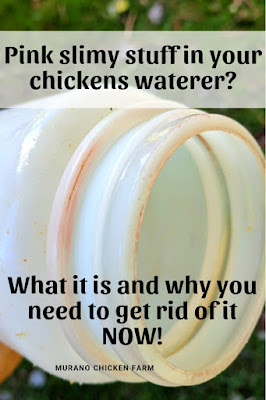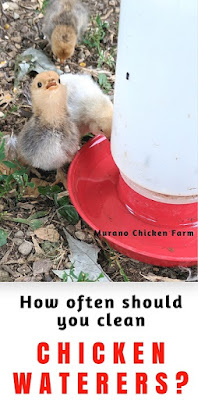If you've ever gone to change the waterer and noticed a slimy sort of substance on the inside of it, you're not cleaning it often enough! I used to think it was just some sort of harmless water residue or debris accumulation and I would clean it out and not worry about it.
It's actually something called biofilm and it's a slimy film of bacteria that stick together to adhere to a surface.
Bacteria that could be in a chickens water bowl/font
There can be many different bacteria in this biofilm including (but not limited to) E coli, salmonella or even bordetella. If the color of the slime is slightly pink or light rust colored, that indicates the presence of a nasty bacteria called Serratia Marcescens aka pink slime and yes, it's as gross as it sounds!
Since most commercially available chicken drinker bases are red, it's not always easy to see. These bacteria can also accumulate in the threads that screw the two pieces together, inside the water container, or inside the screw threads in the base of the waterer.
You'll notice a slightly red tinged film. You may also feel a slimy sort of coating if you run your fingers inside the water container. I have good news though, all you have to do is clean it!
Back when I first started raising chickens, I used to think that I could just rinse it out real good and the poultry drinker will be clean. Give it a swipe with a sponge or brush and that's all it needed. Unfortunately, I needed to do a little more work than that.
How to clean a chickens waterer
Waterers need scrubbed inside and out with hot soapy water, rinsed then allowed to air dry before filling them again. A baby bottle brush can help to get inside all the threads and to the hard to reach bottom of the water containers on chick drinkers.
Save yourself some money and pick one up at the dollar store with these other common chicken supplies. An old toothbrush can also be useful for hard to reach areas.
Now I like to rinse mine with an Oxine Ah solution after washing to kill any remaining bacteria. A bleach solution of 2 teaspoons of bleach to one gallon of water can be used instead. Soak for 2 minutes then allow to air dry.
It's the combination of physically removing the biofilm with scrubbing, then sanitizing and air drying that will kill all the bacteria that might be present.
If you have the fancy poultry drinking system with nipple fonts you may think you're off the hook. Only part way. While these types of systems do keep bacteria to a minimum they still need taken down and cleaned out every 4 months or so.
The pipes of the drinking systems can form biofilm inside them which needs cleaned out to protect the health of the chickens. I'm going to send you over to the University of Georgia Cooperative Extension to help solve this problem since I don't have first hand experience with these water systems (but they do).
Importance of clean chicken waterers
Let's say you just don't feel like cleaning the water containers out that often, what's the worst that can happen? Since one water source is often used for the whole flock, if any bacteria is present your entire flock would be exposed to it.
Poultry diseases transmitted by water include: chronic respiratory disease, infectious bronchitis, fowl typhoid, Marek's disease, coccidiosis, and Newcastle disease.
Access to clean water is necessary for proper digestion and for egg production. If the water in your chickens drinkers is contaminated, they may choose to not drink as much as they need. This can cause dehydration.
Mild dehydration can cause a dip in egg production or even a forced molt. In young birds their growth may be stunted.
The best way to keep chickens water clean is to thoroughly clean your poultry water containers every single time they need filled. With chicks this end up being a daily occurrence, but their delicate systems can't handle exposure to bacteria.
I keep an extra drinker on hand and just switch them out every day so they always have fresh, clean water. Wash one and set it out to air dry while the chicks are using the other one.
For my adult birds I clean their waterers once or twice a week, depending how fast they go through water. No matter what, I clean them a minimum of once a week.
It's a really simple step to minimize my chickens exposure to harmful bacteria, so I don't mind doing it. Admittedly, I usually wash them in my Outside Sink when weather permits, but the laundry tub works just as well in winter.
I know I wouldn't want to drink out of a cup that had water sitting in it for a week. Why should the chickens?
~L
Want information on raising chickens sent right to your email weekly? Click right here to join my list and get new posts sent directly to you the day they're published ... plus, you'll also get the free download '25 Ways to save money raising chickens'.
This post contains affiliate links. If you chose to purchase something through the link, I will get a small payment from Amazon. It will not affect your purchase price. Click for full disclosure.





I have a 3 gallon nipple waterer that I refill weekly. I always put 2 tablespoons of cider vinegar in it. That really seems to help keep the slime down quite a bit
ReplyDeleteACV is really good for the chickens too!
DeleteI wonder if putting oregano in the water would also help? Two birds, so to speak, natural antibiotic plus help to keep the slime at bay?
ReplyDeleteCarol L
That makes a lot of sense. I don't like usings EO's in chickens water, but I'll give it a try with some dried oregano. Thanks for the idea!
DeleteLisa